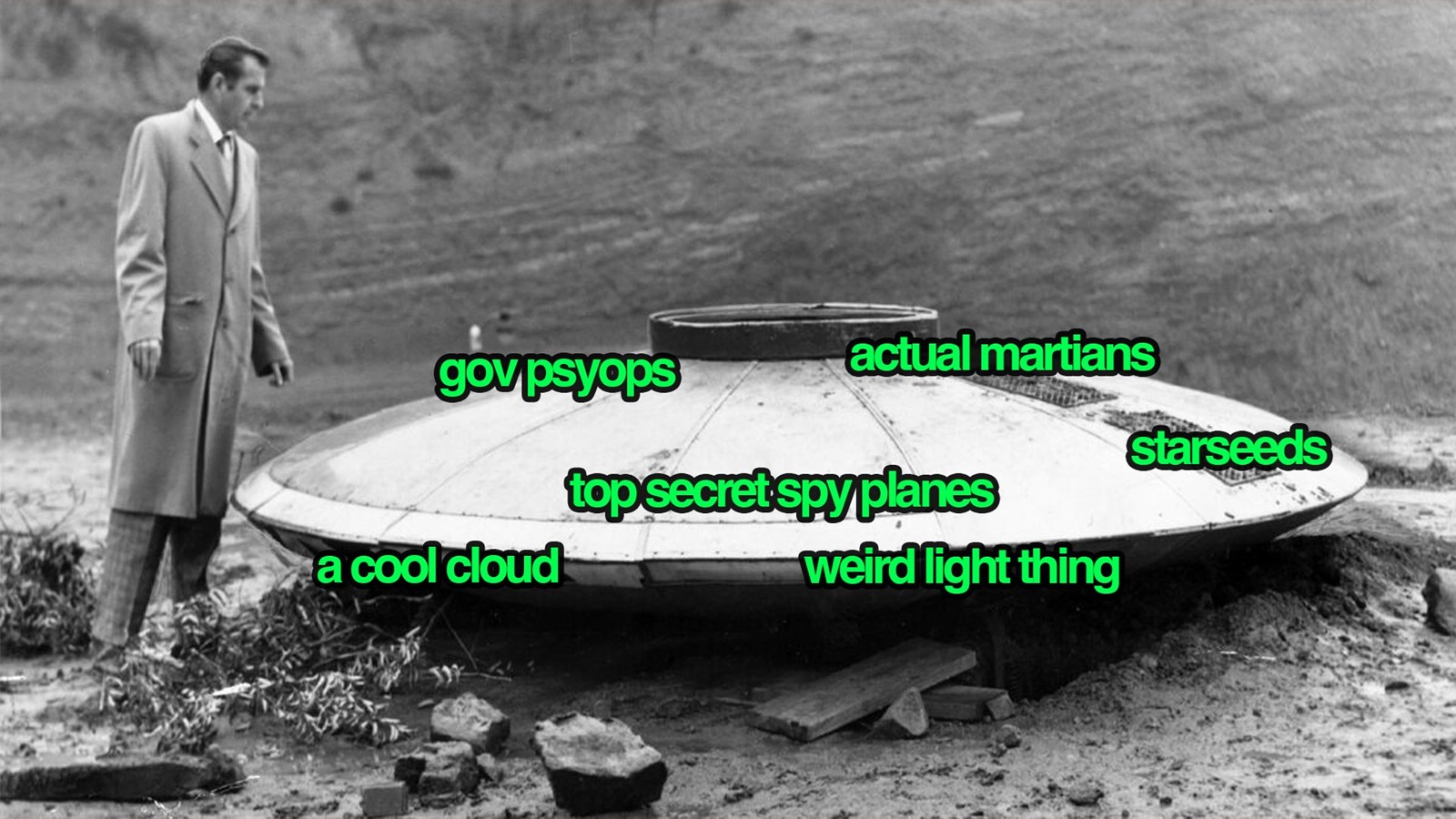Is it a psyop? A government cover-up? Aliens have entered mainstream discourse again, but it’s hard not to question the motives behind how this information is being fed to us – and why
The US government is stashing dead alien bodies in its congressional closet, or at least that’s what whistleblower David Grusch wants us to believe following the UFO hearing in Washington last week. The former intelligence officer went viral last month for claiming that the Pentagon is in possession of “intact and partially intact” alien vehicles, a statement that he refused to elaborate on other than to tease “non-human biological pilots” found at several alleged crash sites. Grusch openly admits to first getting into aliens after reading the now-discredited 2017 New York Times report, yet the ever-alluring promise that intelligent life beyond our planet is just out of reach – or, at least hidden behind many layers of top-level government clearance – has resurfaced in recent years to increasing mainstream attention. Even NASA is taking it seriously.
Mass spectacle aside, the public hearing marks a first in US history. Historically it’s been the case that only the military and national security has access to information about UFOs, or UAPs (unidentified aerial phenomena). Yet, since the pandemic, we’ve seen an uptick in official alien-speak: the Pentagon has opened a new office tasked with investigating UFO reports, there’s an independent, UFO-assessing committee set up by NASA, which is holding public meetings ahead of its final report. There’s even a private company Enigma Labs releasing a UFO report-tracking app. There’s been reports of an alien meteor thought to be found at the bottom of the Pacific Ocean and a large metal cylinder found off a remote beach in Australia. Not to mention the 800-plus UAPs reportedly spotted by airline pilots, the videos of which have been kept out of public reach.
In this new and uncharted era of disinformation, it’s easy to see how stories of technologies of unknown origins, non-human intelligence and unexplained phenomena can fan the flames of cover-ups and conspiratorial thinking (the American public has a right to know!). The idea that the Pentagon is actually in possession of UAPs evokes mental scenes of flashy, X-Men-adjacent Hollywood plots, which is a way easier option than to pause and consider the actual manmade horrors on our shores. Yet, the recent hearing also marks a huge shift in the depiction of aliens across culture, from kooky counterculture to legitimate government narrative. For all this talk of phenomena, mysterious and unexplained, it’s hard not to question the motives behind how this information is being fed to us – and why.
The relationship between alien sightings and government distrust has been around since the very beginning, with early examples such as the 1947 Roswell incident fanning the conspiratorial flames, bringing to light the question of official narratives, who they benefit and why – is it an alien spacecraft or a high-altitude spy balloon? Similarly, extraterrestrial threats have long stood in for geopolitical power, with contemplations of alien existence used as a mask for the development of spy planes. Key figures like Richard Doty, a former Air Force Office of Special Investigations agent, openly admitted to passing fake documents to UFO researchers in the 80s and 90s.
“It’s not surprising to me that we’re talking about aliens in a moment where it’s getting really, really hard to figure out what’s real” – Trevor Paglen
“This UFO belief is intrinsically tied to notions of a government and military cover-up, and is powerful and pervasive within society,” agrees Mark Pilkington, the author of Mirage Men. One particular angle is the relationship between UFOs and the history of military and defence technology development: “Amplifying concerns about unknown, possibly unfriendly objects flying over US skies is of great benefit to the defence industry.” This is no doubt supported by the shift in language in recent years away from UFO, which is wrapped up in green-man-sci-fi connotations, to the more technical-sounding and abstract Unidentified Aerial Phenomena, which accommodates for all matter of unknowns, from surveillance drones to spy balloons, unusual weather or other natural phenomena – “all of which are important in the military domain,” he adds. “It also keeps the discussion grounded in science and credible for those – still the majority – who are not on board with the alien narrative.”
This doesn’t only apply to geopolitical threats but to the individual, too. UFO-speak can be used to manipulate or psyop individuals, capitalising on our differences in perception to create confusion, making it harder to organise counter-narratives against what the government drip-feeds us. This is particularly true as social media chips away at any notion of a consensus reality – young people are increasingly turning to alt media platforms like TikTok as their main news source – which amplifies fringe beliefs and makes it harder to distinguish what’s real or not. “It’s not surprising to me that we’re talking about aliens in a moment where... it’s getting really, really hard to figure out what’s real,” says artist Trevor Paglen, whose work tackles ideas of mass surveillance and government disinformation.
Even the positioning of UAP sightings as classified information plays into this narrative, with officials capitalising on our collective distrust of mainstream media to uncover hidden truths – as one official said at last week’s congressional hearing, “we can’t be afraid of asking questions and we can’t be afraid of the truth”. So, whether there are actually intelligent aliens out there communicating with a secret part of the Deep State or not, there’s a gamification involved in unearthing classified information, which only adds further incentive to the cause. Paglen elaborates, “It presents itself as a secret that’s being revealed, and that secret is more likely to be true than the bullshit that’s already been given to you.”
But it’s not just government disinformation that’s contributing to this current wave of UFOria. The past few years have seen a shift away from the fedora-tipping Reddit atheism of the late aughts towards a nu-spiritualism, as people turn to the mystical to make sense of an increasingly unreal present. Rapid advances in technology are upturning the laws of physics – AI can unearth ancient languages, while ancient worms trapped in the permafrost for thousands of years are breathing new life – summoning a perpetual state of snowballing weirdness that writer Venkatesh Rao refers to as The Permaweird: the idea that the world has got more complex than we can imagine that we resort to magical thinking, where “social fictions indistinguishable from religious eschatologies”, to cope.
When everyday life begins to resemble a sci-fi plot and news headlines hail new scientific breakthroughs that challenge our preexisting assumptions of the world, let alone time itself, the idea that aliens might walk among us doesn’t seem all that strange. Even better, it poses a quasi-scientific belief system that’s literally endorsed by the government and NASA. Tin hat or not, it’s important to consider why these conversations are entering the mainstream now – and it’s not a coincidence that it’s during a time when space tourism is on the rise and conversations around AI and non-human intelligence are reaching their peak and posing very real existential threats.
With the unimaginable existing everywhere, it’s hard not to get sidetracked when listening to the congressional hearing, its high-profile, intentionally confusing spectacle setting the stage for further speculation, while keeping us distracted from anything more shadowy beneath the surface. As with all conspiracies, there is an element of truth: yes, we’re facing huge existential threats, and yes, there are unidentified aerial phenomena flying around in the air (though apparently only in the US). But perhaps we need to consider the very real threats on Earth before shooting our troubles into the skies.
Join Dazed Club and be part of our world! You get exclusive access to events, parties, festivals and our editors, as well as a free subscription to Dazed for a year. Join for £5/month today.
















